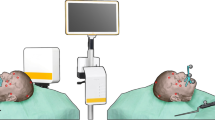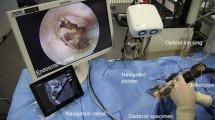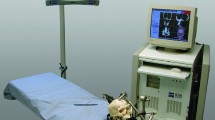Abstract
The present study examined electromagnetic tracking technology for ENT navigation. Five different registration modalities were compared and navigation accuracy was assessed. Four skull models were individually fabricated with a three-dimensional printer, based on patients’ computer tomography datasets. Individual silicone masks were fitted for skin and soft tissue simulation. Five registration modalities were examined: (1) invasive marker, (2) automatic, (3) surface matching (AccuMatch), (4) anatomic landmarks, and (5) oral splint registration. Overall navigation accuracy and accuracy on selected anatomic locations were assessed by targeting 26 titanium screws previously placed over the skull. Overall navigation accuracy differed significantly between all registration modalities. The target registration error was 0.94 ± 0.06 mm (quadratic mean ± standard deviation) for the invasive marker registration, 1.41 ± 0.04 mm for the automatic registration, 1.59 ± 0.14 mm for the surface matching registration, and 5.15 ± 0.66 mm (four landmarks) and 4.37 ± 0.73 mm (five landmarks) for the anatomic landmark registration. Oral splint registration proved itself to be inapplicable to this navigation system. Invasive marker registration was superior on most selected anatomic locations. However, on the ethmoid and sphenoid sinus the automatic registration process revealed significantly lower target registration error values. Only automatic and surface registration met the accuracy requirements for noninvasive registration. Particularly, the automatic image-to-world registration reaches target registration error values on the anterior skull base which are comparable with the gold standard of invasive screw registration.




Similar content being viewed by others
References
Ecke U, Luebben B, Maurer J, Boor S, Mann WJ (2003) Comparison of different computer-aided surgery systems in skull base surgery. Skull Base 13(1):43–50
Rosenow JM, Sootsman WK (2007) Application accuracy of an electromagnetic field-based image-guided navigation system. Stereotact Funct Neurosurg 85(2–3):75–81
Irugu DV, Stammberger HR (2014) A note on the technical aspects and evaluation of the role of navigation system in endoscopic endonasal surgeries. Indian J Otolaryngol Head Neck Surg 66(Suppl 1):307–313. doi:10.1007/s12070-011-0380-x
Koele W, Stammberger H, Lackner A, Reittner P (2002) Image guided surgery of paranasal sinuses and anterior skull base—five years experience with the InstaTrak-System. Rhinology 40(1):1–9
Eboli P, Shafa B, Mayberg M (2011) Intraoperative computed tomography registration and electromagnetic neuronavigation for transsphenoidal pituitary surgery: accuracy and time effectiveness. J Neurosurg 114(2):329–335. doi:10.3171/2010.5.JNS091821
Kral F, Puschban EJ, Riechelmann H, Pedross F, Freysinger W (2011) Optical and electromagnetic tracking for navigated surgery of the sinuses and frontal skull base. Rhinology 49(3):364–368. doi:10.4193/Rhino10.177
Mert A, Gan LS, Knosp E, Sutherland GR, Wolfsberger S (2013) Advanced cranial navigation. Neurosurgery 72(Suppl 1):43–53. doi:10.1227/NEU.0b013e3182750c03
Fried MP, Kleefield J, Gopal H, Reardon E, Ho BT, Kuhn FA (1997) Image-guided endoscopic surgery: results of accuracy and performance in a multicenter clinical study using an electromagnetic tracking system. Laryngoscope 107(5):594–601
Reittner P, Tillich M, Luxenberger W, Weinke R, Preidler K, Kole W, Stammberger H, Szolar D (2002) Multislice CT-image-guided endoscopic sinus surgery using an electromagnetic tracking system. Eur Radiol 12(3):592–596. doi:10.1007/s00330-001-1200-6
Hardy SM, Melroy C, White DR, Dubin M, Senior B (2006) A comparison of computer-aided surgery registration methods for endoscopic sinus surgery. Am J Rhinol 20(1):48–52
Claes J, Koekelkoren E, Wuyts FL, Claes GM, Van den Hauwe L, Van de Heyning PH (2000) Accuracy of computer navigation in ear, nose, throat surgery: the influence of matching strategy. Arch Otolaryngol Head Neck Surg 126(12):1462–1466
Eggers G, Muhling J (2007) Template-based registration for image-guided skull base surgery. Otolaryngol Head Neck Surg 136(6):907–913
Luebbers HT, Messmer P, Obwegeser JA, Zwahlen RA, Kikinis R, Graetz KW, Matthews F (2008) Comparison of different registration methods for surgical navigation in cranio-maxillofacial surgery. J Craniomaxillofac Surg 36(2):109–116
Cartellieri M, Vorbeck F (2000) Endoscopic sinus surgery using intraoperative computed tomography imaging for updating a three-dimensional navigation system. Laryngoscope 110(2 Pt 1):292–296
Bernardeschi D, Nguyen Y, Villepelet A, Ferrary E, Mazalaigue S, Kalamarides M, Sterkers O (2013) Use of bone anchoring device in electromagnetic computer-assisted navigation in lateral skull base surgery. Acta Otolaryngol 133(10):1047–1052. doi:10.3109/00016489.2013.808764
Caversaccio M, Nolte LP, Hausler R (2002) Present state and future perspectives of computer aided surgery in the field of ENT and skull base. Acta Otorhinolaryngol Belg 56(1):51–59
Widmann G, Stoffner R, Bale R (2009) Errors and error management in image-guided craniomaxillofacial surgery. Oral Surg Oral Med Oral Pathol Oral Radiol Endod 107(5):701–715
Loubele M, Van Assche N, Carpentier K, Maes F, Jacobs R, van Steenberghe D, Suetens P (2008) Comparative localized linear accuracy of small-field cone-beam CT and multislice CT for alveolar bone measurements. Oral Surg Oral Med Oral Pathol Oral Radiol Endod 105(4):512–518. doi:10.1016/j.tripleo.2007.05.004
Widmann G, Zangerl A, Schullian P, Fasser M, Puelacher W, Bale R (2012) Do image modality and registration method influence the accuracy of craniofacial navigation? J Oral Maxillofac Surg 70(9):2165–2173. doi:10.1016/j.joms.2011.08.026
Lihong X, Heng L, Gyanwali B, Meichan Z, Kaiquan Z, Kai S, Anzhou T (2015) Micro-computed tomography and microdissection of the temporal bone of tree shrews. Ann Anat. doi:10.1016/j.aanat.2015.08.005
Lee DH, Chan S, Salisbury C, Kim N, Salisbury K, Puria S, Blevins NH (2010) Reconstruction and exploration of virtual middle-ear models derived from micro-CT datasets. Hear Res 263(1–2):198–203. doi:10.1016/j.heares.2010.01.007
Orhan AI, Orhan K, Ozgul BM, Oz FT (2015) Analysis of pulp chamber of primary maxillary second molars using 3D micro-CT system: an in vitro study. Eur J Paediatr Dent 16(4):305–310
Eggers G, Muhling J, Marmulla R (2006) Image-to-patient registration techniques in head surgery. Int J Oral Maxillofac Surg 35(12):1081–1095. doi:10.1016/j.ijom.2006.09.015
Grunert P, Darabi K, Espinosa J, Filippi R (2003) Computer-aided navigation in neurosurgery. Neurosurg Rev 26(2):73–99 (discussion 100–1)
Knott PD, Batra PS, Butler RS, Citardi MJ (2006) Contour and paired-point registration in a model for image-guided surgery. Laryngoscope 116(10):1877–1881
Walker DG, Ohaegbulam C, Black PM (2002) Frameless stereotaxy as an alternative to fluoroscopy for transsphenoidal surgery: use of the InstaTrak-3000 and a novel headset. J Clin Neurosci 9(3):294–297
Javer AR, Kuhn FA, Smith D (2000) Stereotactic computer-assisted navigational sinus surgery: accuracy of an electromagnetic tracking system with the tissue debrider and when utilizing different headsets for the same patient. Am J Rhinol 14(6):361–365
Eggers G, Muhling J, Marmulla R (2005) Template-based registration for image-guided maxillofacial surgery. J Oral Maxillofac Surg 63(9):1330–1336. doi:10.1016/j.joms.2005.05.312
Wise SK, DelGaudio JM (2005) Computer-aided surgery of the paranasal sinuses and skull base. Expert Rev Med Devices 2(4):395–408
Grauvogel TD, Soteriou E, Metzger MC, Berlis A, Maier W (2010) Influence of different registration modalities on navigation accuracy in ear, nose, and throat surgery depending on the surgical field. Laryngoscope 120(5):881–888. doi:10.1002/lary.20867
Metzger MC, Rafii A, Holhweg-Majert B, Pham AM, Strong B (2007) Comparison of 4 registration strategies for computer-aided maxillofacial surgery. Otolaryngol Head Neck Surg 137(1):93–99
West JB, Fitzpatrick JM, Toms SA, Maurer CR Jr, Maciunas RJ (2001) Fiducial point placement and the accuracy of point-based, rigid body registration. Neurosurgery 48(4):810–816 (discussion 816–7)
Citardi MJ, Batra PS (2007) Intraoperative surgical navigation for endoscopic sinus surgery: rationale and indications. Curr Opin Otolaryngol Head Neck Surg 15(1):23–27
Fitzpatrick JM, West JB, Maurer CR Jr (1998) Predicting error in rigid-body point-based registration. IEEE Trans Med Imaging 17(5):694–702. doi:10.1109/42.736021
Strauss G, Hofer M, Korb W, Trantakis C, Winkler D, Burgert O, Schulz T, Dietz A, Meixensberger J, Koulechov K (2006) Accuracy and precision in the evaluation of computer assisted surgical systems. A definition. HNO 54(2):78–84
Kristin J, Mucha D, Schipper J, Klenzner T (2012) Registration strategies for the application of the navigation system Fiagon at the lateral scull base. Laryngorhinootologie 91(5):306–310. doi:10.1055/s-0031-1299755
Mascott CR, Sol JC, Bousquet P, Lagarrigue J, Lazorthes Y, Lauwers-Cances V (2006) Quantification of true in vivo (application) accuracy in cranial image-guided surgery: influence of mode of patient registration. Neurosurgery 59(1 Suppl 1):ONS146–ONS156 (discussion ONS146–56)
Pillai P, Sammet S, Ammirati M (2008) Application accuracy of computed tomography-based, image-guided navigation of temporal bone. Neurosurgery 63(4 Suppl 2):326–332. doi:10.1227/01.NEU.0000316429.19314.67 (discussion 332–3)
Makiese O, Pillai P, Salma A, Sammet S, Ammirati M (2010) Accuracy validation in a cadaver model of cranial neuronavigation using a surface autoregistration mask. Neurosurgery 67(3 Suppl Operative):ons85–ons90. doi:10.1227/01.NEU.0000383751.63835.2F (discussion ons90)
Ibrahim AA, Magdy EA, Eid M (2012) Endoscopic endonasal multilayer repair of traumatic ethmoidal roof cerebrospinal fluid rhinorrhea in children. Int J Pediatr Otorhinolaryngol 76(4):523–529. doi:10.1016/j.ijporl.2012.01.009
Arapakis I, Hubbe U, Maier W, Laszig R, Schipper J (2005) LED autoregistration in navigated endonasal sinus surgery. Laryngorhinootologie 84(6):418–425. doi:10.1055/s-2004-825998
Marmulla R, Luth T, Muhling J, Hassfeld S (2004) Automated laser registration in image-guided surgery: evaluation of the correlation between laser scan resolution and navigation accuracy. Int J Oral Maxillofac Surg 33(7):642–648
Raabe A, Krishnan R, Wolff R, Hermann E, Zimmermann M, Seifert V (2002) Laser surface scanning for patient registration in intracranial image-guided surgery. Neurosurgery 50(4):797–801 (discussion 802–3)
Schicho K, Figl M, Seemann R, Donat M, Pretterklieber ML, Birkfellner W, Reichwein A, Wanschitz F, Kainberger F, Bergmann H, Wagner A, Ewers R (2007) Comparison of laser surface scanning and fiducial marker-based registration in frameless stereotaxy. Technical note. J Neurosurg 106(4):704–709
Schlaier J, Warnat J, Brawanski A (2002) Registration accuracy and practicability of laser-directed surface matching. Comput Aided Surg 7(5):284–290
Miller RS, Hashisaki GT, Kesser BW (2006) Image-guided localization of the internal auditory canal via the middle cranial fossa approach. Otolaryngol Head Neck Surg 134(5):778–782. doi:10.1016/j.otohns.2005.12.015
Fright WR, Linney AD (1993) Registration of 3-D head surfaces using multiple landmarks. IEEE Trans Med Imaging 12(3):515–520. doi:10.1109/42.241879
Pfisterer WK, Papadopoulos S, Drumm DA, Smith K, Preul MC (2008) Fiducial versus nonfiducial neuronavigation registration assessment and considerations of accuracy. Neurosurgery 62(3 Suppl 1):201–207 (discussion 207–8)
Balachandran R, Fitzpatrick JM, Labadie RF (2008) Accuracy of image-guided surgical systems at the lateral skull base as clinically assessed using bone-anchored hearing aid posts as surgical targets. Otol Neurotol 29(8):1050–1055
Labadie RF, Davis BM, Fitzpatrick JM (2005) Image-guided surgery: what is the accuracy? Curr Opin Otolaryngol Head Neck Surg 13(1):27–31
Acknowledgments
The authors thank Professor Dr. J. Schulte-Moenting from the Institute of Biostatistic and Medical Informatics, University of Freiburg, Germany, for his support in statistical analysis and Ms. I. Neu, make-up artist at the theater of Freiburg, Germany, for fabricating the silicone masks.
Author information
Authors and Affiliations
Corresponding author
Ethics declarations
Funding
The work was supported by the Faculty of Medicine, Albert-Ludwigs-University of Freiburg, Germany.
Conflict of interest
Author Soteriou, E. declares that he has no conflict of interest. Author Grauvogel, J. declares that he has no conflict of interest. Author Laszig, R. declares that he has no conflict of interest. Author Grauvogel, T. D. declares that she has no conflict of interest.
Ethical standards
This article does not contain any studies with human participants or animals performed by any of the authors.
Rights and permissions
About this article
Cite this article
Soteriou, E., Grauvogel, J., Laszig, R. et al. Prospects and limitations of different registration modalities in electromagnetic ENT navigation. Eur Arch Otorhinolaryngol 273, 3979–3986 (2016). https://doi.org/10.1007/s00405-016-4063-9
Received:
Accepted:
Published:
Issue Date:
DOI: https://doi.org/10.1007/s00405-016-4063-9




